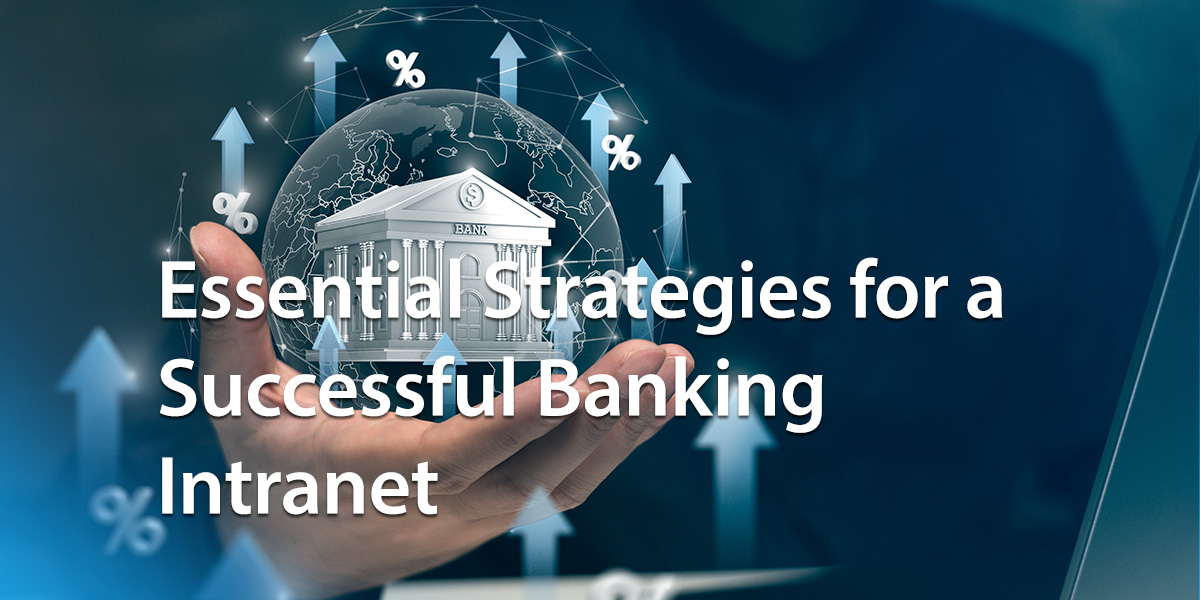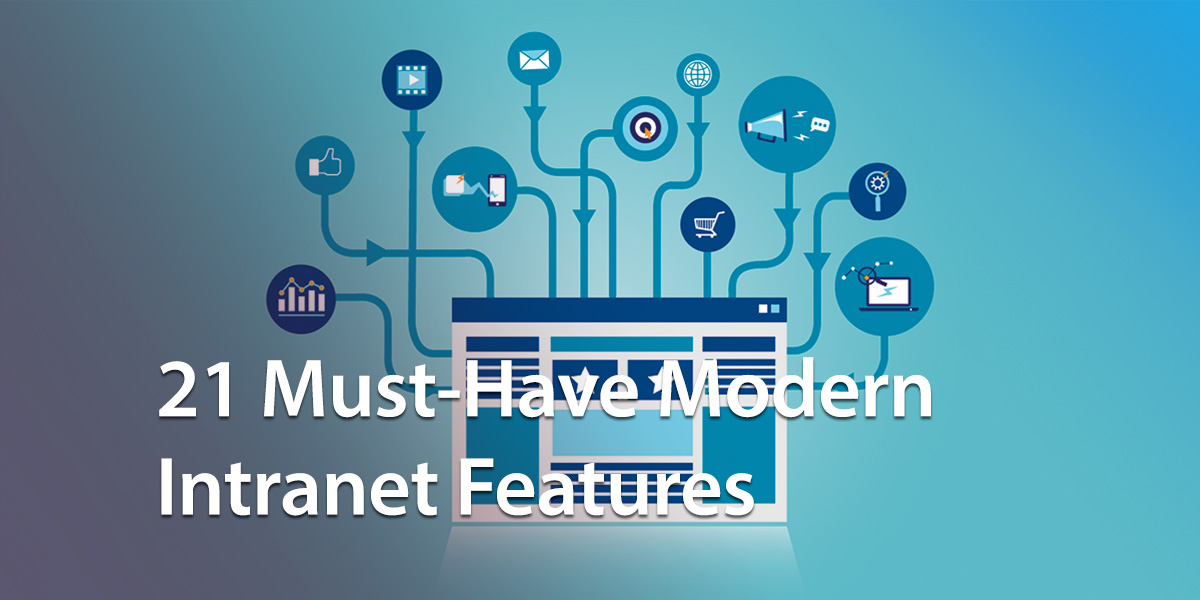Like any company, banks, and financial institutions need technological solutions to support core business functions like internal communications and knowledge sharing. However, financial organizations face unique needs, with security and compliance at the top of their list of requirements. A banking intranet is the perfect solution. It combines cutting-edge security features with seamless collaboration and streamlined internal processes to boost productivity and customer services.
More and more banks and other financial organizations are adopting intranet software to power their digital workplace. This post walks you through everything you need to know, including the following:
- Definition of banking intranets
- Benefits of an intranet for banks
- Suggested use cases
- How to plan and design an intranet platform
- Essential features
- Case study examples of banking intranets
What Are Banking Intranets?
Banking or financial intranets are private, secure networks used within financial institutions to facilitate internal communication, collaboration, and information sharing.
While it is possible to build an intranet from scratch and host it on-premise, most modern intranets are cloud-based and hosted by specialist providers.
Sensitive personnel data is the daily currency of banks and financial institutions. Modern intranets incorporate the latest measures to ensure a secure online environment, including SSL encryption, access controls, and multi-factor authentication.
Benefits Of An Intranet For Banks
Whether you are a bank or credit union or operate within the financial industry, intranets offer an integrated suite of tools within a single platform. Here are the headline benefits you need to know:
- Improve internal communication and collaboration among employees
- Enhance employee engagement, knowledge sharing, and management
- Boost productivity and efficiency in core business functions
- Support compliance and data control requirements
- Provide a centralized platform for information sharing and access
- Enhance customer service for clients
The bottom line is that intranets connect employees and provide full access to the information needed to get things done under one virtual roof.
Furthermore, modern intranets integrate seamlessly with enterprise systems, such as HR and payroll apps, CRM software, and accountancy platforms like MYOB. Single sign-on means employees no longer have to toggle between different screens. Instead, employees enjoy a superior user experience with gateway access to the digital workplace.
Suggested Use Cases For Your Intranet Software
Every financial organization has unique needs and you may be wondering how an intranet can help. Here are some use cases to inspire and motivate you to get the most out of the software.
Boost Employee Engagement
Challenges: The financial industry is known for its high-pressure environment. Tight deadlines, heavy workloads, and the pressure to comply with ever-changing regulations can take a toll on engagement. Banking and finance also have a large number of remote workers. According to the latest statistics, 61 percent of full-time finance employees and 25 percent of part-time ones can work remotely.
Solution: An intranet for banks can help you address the challenges that impact employee engagement. Here’s how:
- Use the company’s intranet to support internal communication and collaboration, with team chat, # channels, and news feeds
- Encourage employee participation and feedback to senior management through interactive blogs, surveys, and polls
- Recognize and reward employee contributions and achievements. Research from Gallup confirms that doing so not only boosts employee engagement but also powers up productivity
- Provide training and development opportunities from internal mentoring programs, webinars, and lunch-and-learns to external courses and certifications
Knowledge Management for Financial Organizations
Challenges: Banks, credit unions, and other financial organizations generate vast amounts of data daily. From customer information to regulatory updates, there’s much to keep on top of. Moreover, departments within financial institutions often operate in silos. Information and data are fragmented. Employees can struggle to find what they need without a central knowledge base.
Solution: The intranet’s centralized knowledge base ensures information is organized and shared efficiently and effectively. It offers a single source of truth for management and employees. Policy management and version control are simplified in a digital platform, as previous versions of documents can be deleted and updated.
Here are some other ways your intranet can support knowledge sharing and management:
- Develop a knowledge base with relevant information and resources
- Use tagging and categorization to make content easily searchable
- Encourage employees to share files, knowledge, and expertise
- Provide access to industry news and updates
- Improve services to customers with quick access to knowledge and information
Data Control and Compliance
Challenges: Whether it’s GDPR or GLBA, the list of compliance requirements for the finance industry grows longer each year. Moreover, effective data governance involves establishing policies and procedures for data management, and ensuring employees adopt correct procedures to safeguard sensitive information.
Solution: The intranet’s centralized platform enhances regulatory compliance. Up-to-date information means all employees have the latest guidelines at their fingertips. Furthermore, controlled access and secure communication channels strengthen data security and reduce the risk of breaches.
In addition, the following tools will help you stay on top of data control and compliance:
- Use automated tools to manage data retention and deletion
- Develop workflows to ensure compliance with regulatory requirements
- Implement access control measures to protect sensitive information and restrict access to authorized personnel
- Monitor and audit user activity
How To Plan and Design A Banking Intranet
Ready to take the next step? Getting started on your financial intranet is easy with our simple four-step process:
1. Define Goals and Objectives
Defining your goals and objectives is the essential starting point. What challenges are you facing that the intranet needs to address? It could be improving communication or streamlining workflows. Understanding your goals and objectives will help you determine the essential tools and features you need.
2. Choose The Right Platform
With a clear view of what you want to achieve, you can go out into the market and research the options. And there are plenty to choose from, so look for a user-friendly platform that aligns with your needs and objectives. Things to look out for include ease of use, scalability, security features, integration capabilities, and the UX. Also check out the customer support options. You want a responsive provider that’s available to answer your queries.
3. Evaluating Intranet Solutions
By now, you should have a shortlist of contenders. But how do you evaluate the different options? Most intranet providers offer free demos or, even better, trial offers. Take advantage of the opportunity to really test out the software. Also, check out independent review sites for honest customer appraisals.
At the end of the day, you want a solution that offers clear navigation menus, advanced search, personalized updates, and a user-friendly UI. And make sure the software is available as a mobile app to support remote and on-the-go employees.
4. Implement And Train
Fully customizable, pre-built intranet templates make implementing your intranet straightforward. This means your intranet can be up and running in no time – a huge benefit in the fast-paced financial services environment.
All that’s left to do is provide staff training to ensure your teams are comfortable using the software and know how to get the best out of it.
Key Features for Banking Intranets
Still unsure about the right platform? We get it. Choosing the best intranet solution for your bank or credit union can be daunting. We’ve made the task more straightforward with the following list of key features relevant to the financial industry.
Central Knowledge Hub
This must-have feature is top of the list. All bank-related information is available in one central resource, from product updates to compliance guidelines. Collaborating and sharing internal knowledge and expertise are more straightforward when you have an intranet.
Digital Forms And Workflows
Digital processes are critical. Faster and more accurate, they streamline operations and ensure you deliver a better service to bank customers.
Personalized Updates
Tailored updates feeds like MyHub’s keep everyone in the organization, from corporate to branch, informed about relevant news and announcements. Everyone is on the same page.
Employee Directory
An interactive employee directory connects team members, whatever their location, saving time and improving communication. This handy tool enhances collaboration and efficiency, making finding the right person for any task a breeze.
Document Management
A robust document management system ensures proper version control, and makes teamwork seamless and effective.
Advanced Security
Last but by no means least, advanced security features are essential. Your financial intranet must provide secure data storage and access to safeguard sensitive information from unauthorized access.
Choose a solution with the latest security features, such as end-to-end encryption, multi-factor authentication, access controls, and regular security audits.
Financial Institution Intranets: Real-World Case Studies
We finish our comprehensive discussion on intranets for financial services with a look at what’s happening in the real world. Check out the following case studies and explore how banks and credit unions use their intranets.
Louisiana-based JD Bank revamped its intranet to address challenges like outdated systems and scattered information. The new platform created a central source for all internal documents, bank policies, forms, and procedures, improving access to critical business systems.
JD Bank emphasized the corporate culture by enabling bank employees to share news, events, and photos. The intranet allowed departments to manage their content independently while improving engagement with features like contests and comments.
Farm Bureau Bank implemented a social intranet called The Insider to power up internal communication. Initially designed to improve top-down messaging, it soon became an essential tool for boosting company culture and employee engagement.
Features like employee recognition shout outs and the virtual water cooler Barn Yard were used to develop a sense of community. They also helped employees from different departments connect better, ultimately boosting collaboration and the employee experience.
It’s not just banks that can benefit from an intranet. Other finance organizations, including credit unions, have much to gain. Canada’s DUCA Financial Services Credit Union faced significant challenges with its outdated, inefficient, and difficult-to-manage intranet. The platform got in the way of cohesive communication across its various branches and lacked engaging, interactive features.
DUCA transitioned to a new, user-friendly platform and the company hasn’t looked back. Among the many benefits is enhanced employee engagement, thanks to more interactive tools and social features. Furthermore, the intranet platform has made it easier for employees to access the information they need, improving operational efficiency.
Intranet For Banks: Key Takeaways
When it comes to more efficient experiences for employees, clients, and customers, intranet solutions for banks are hard to beat.
Under one virtual roof are all the tools and resources your people need to achieve success in their daily work. Customers benefit from faster, more responsive services. And employees feel more informed, involved, and motivated. It’s a win-win, so use the essential strategies we’ve shared and get started on your intranet today.
About MyHub
MyHub’s software is designed to help your financial institution tackle its unique challenges. Your team will love our user-friendly, easy-to-setup, and manage software. And with a mobile app, employees can access vital information exactly when they need it.
Our software includes all the essential features for a top-tier financial intranet. Here are some standouts that make our software the preferred choice for financial services companies:
- Over 60 integrations with enterprise systems
- Specialized mobile app
- 60+ pre-built templates
- Team chat
- Personalized updates feed pulling notifications and updates from across the site
Discover these tools and more in our highlights video, a free demo, or a 14-day no-obligation trial.











0 Comments